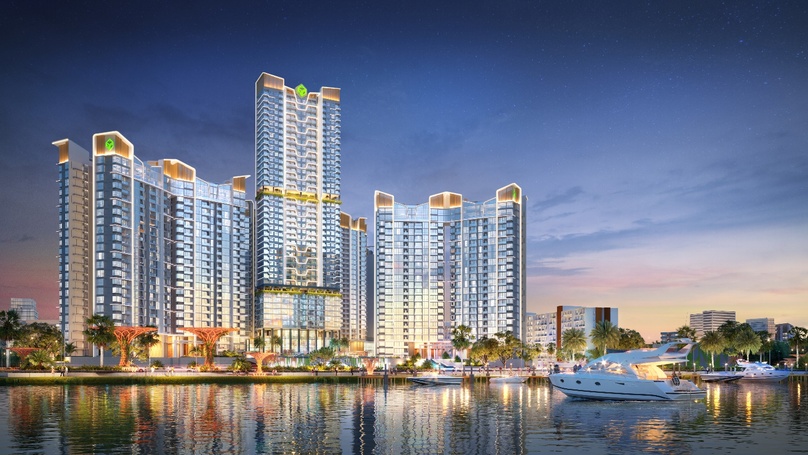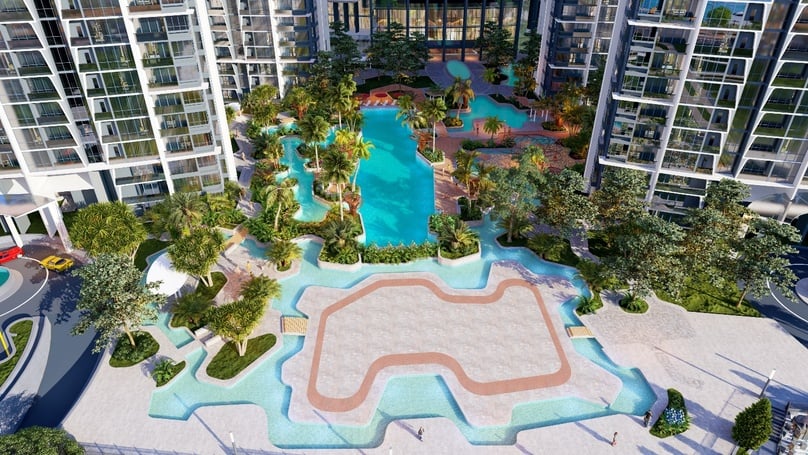Large-scale infrastructure projects add vitality to southern HCMC real estate
Major improvements in transport infrastructure in recent years have given a fillip to the real estate market in the southern area of Ho Chi Minh City.
Accelerated infrastructure developments demonstrate that the property market in southern HCMC is preparing to enter its next development cycle, after the first in the 90s, major developer Novaland said in a release.
"With this development cycle, southern HCMC is forecast to become an urban area with the color of an international riverside financial center - a multifunctional mix of commerce, service, science, clean industry, education, entertainment and resort, similar to successful models like that in Manhattan (U.S.), Zurich (Switzerland), Yeoui-dong (South Korea) and Singapore," it said.

An illustration of The Grand Sentosa project in the south of HCMC. Photo courtesy of Nova Group.
A plot of "golden" land in the south of the city is emerging as a project featuring the breath of the island state of Singapore. The Grand Sentosa, with three large street frontages and two sides facing a river, is ideal in the Vietnamese perception of selecting a house. It also provides comfort by connecting to the region's most outstanding utilities.
Inspired by Singapore in terms of green coverage, modernity and excitement, The Grand Sentosa possesses natural ecological advantages and "flows of prosperity", creating a place of residence with countless experiences of healthy living, both physically and mentally, and bringing to its residents premium comfortable living experiences - a Singaporean-standard lifestyle in the heart of southern HCMC, according to the project investor Novaland.
Similar to Singapore's Sentosa Island with 70% of its area as tropical forests, the project owns a green density of up to 71% of its total area. Its landscape planning focuses on nature conservation, which is interspersed with modern utilities, creating a complex of high-end commercial services and housing.
"Owning a home in The Grand Sentosa is owning a powerful passport with exclusive privileges, from luxurious facilities like a private marina, riverside pedestrian street, entertainment square, Singaporean-style experiences in the middle of HCMC like 71% green density, a chain of modern shopping centers and high-end health treatments," the firm added.
"We believe that The Grand Sentosa apartment complex not only adds the supply of housing and commercial real estate but also contributes to changing the face of the urban area in the south of the city," a representative of Novaland said.
With continuous development of infrastructure and efforts of real estate developers in providing many utilities and green landscapes in such projects, the southern part of HCMC promises to continue growing more strongly in future.

“Green” and comfortable living space at The Grand Sentosa. Photo courtesy of Nova Group.
Infrastructure - leverage for development in the south
Southern HCMC, including District 7, Nha Be district and part of Binh Chanh district, has been properly planned in the last decades to become an urban area in the heart of the city. That orientation together with synchronous infrastructure development and rapid urban development have made the population density of southern HCMC increase. The urban area has increasingly expanded and become crowded.
To realize the vision of turning HCMC into a smart city in the short and medium term, the urban infrastructure in southern HCMC is expected to undergo many important changes to relieve traffic and infrastructure bottlenecks to match the development speed of this dynamic area.
HCMC's Department of Transport and related units have constantly researched and proposed a series of traffic projects aimed at solving bottlenecks, said Vuong Quang Hung, head of the HCMC Department of Transport's road construction management department.
Among the many major infrastructure projects is the system of tunnels and overpasses at the Nguyen Van Linh-Nguyen Huu Tho street intersection (District 7) on which phase 1 construction has commenced.
Two other key projects include Thu Thiem 3 Bridge, connecting the Thu Thiem new urban area in District 2 and District 4, and Thu Thiem 4 Bridge, connecting District 2 and District 7 - Phu My Bridge, with an investment scale of thousands of billions of Vietnamese dong (VND1,000 billion = $42.69 million).
Besides, a series of other key projects in this area are being accelerated like Nguyen Khoai Bridge, connecting District 7 and District 4, with investment capital of VND1,250 billion ($53.37 million).
Another is the project to expand Nguyen Tat Thanh street in District 4; and the North-South axis road project connecting the central area with districts 4, 7 and Nha Be district, with a total estimated cost exceeding VND8,500 billion.
"These projects, when completed, will be the foundation for the long-term development of southern HCMC, as well as the basis for attracting real estate investment projects and for mobilizing investment capital.
Currently, HCMC is outlining an infrastructure development project for the period of 2020-2025. The project needs to be approved and implemented soon to create a push for the southern area of the city in the near future," Hung added.
- Read More
Southern Vietnan port establishes strategic partnership with Japan’s Port of Kobe
Long An International Port in Vietnam’s southern province of Tay Ninh and Japan’s Port of Kobe on Monday signed an MoU establishing a strategic port partnership which is expected to boost trade flows, cut logistics costs, and deliver greater benefits to businesses across the region.
Companies - Wed, November 19, 2025 | 10:14 am GMT+7
Thaco's agri arm seeks to expand $44 mln cattle project in central Vietnam
Truong Hai Agriculture JSC (Thaco Agri), the agriculture arm of conglomerate Thaco, looks to aggressively expand its flagship cattle farming project in the central Vietnam province of Gia Lai.
Industries - Wed, November 19, 2025 | 9:56 am GMT+7
Japan food major Acecook eyes new plant in southern Vietnam
Acecook, a leading instant noodle maker with 13 plants operating in Vietnam, is studying a new project in the southern province of Tay Ninh.
Industries - Wed, November 19, 2025 | 9:39 am GMT+7
Vietnam’s largest Aeon Mall to take shape in Dong Nai province
Authorities of Dong Nai province, a manufacturing hub in southern Vietnam, on Monday awarded an investment registration certificate to Japanese-invested Aeon Mall Vietnam Co., Ltd. for its Aeon Mall Bien Hoa project.
Industries - Tue, November 18, 2025 | 8:17 pm GMT+7
Police propose prosecuting Egroup CEO Nguyen Ngoc Thuy for fraud, bribery
Vietnam’s Ministry of Public Security has proposed prosecuting Nguyen Ngoc Thuy, chairman and CEO of Hanoi-based education group Egroup, along with 28 others, for fraud to appropriate property, giving bribes, and receiving bribes.
Society - Tue, November 18, 2025 | 4:01 pm GMT+7
Singapore-backed VSIP eyes large urban-industrial complex in southern Vietnam
A consortium involving VSIP, a joint venture between local developer Becamex IDC and Singapore’s Sembcorp, plans a large-scale urban-industrial development named the "Moc Bai Xuyen A complex along the Tay Ninh-Binh Duong economic corridor in southern Vietnam.
Industrial real estate - Tue, November 18, 2025 | 2:38 pm GMT+7
Aircraft maintenance giant Haeco to set up $360 mln complex in northern Vietnam
Hong Kong-based Haeco Group, Vietnam's Sun Group, and some other partners plan to invest $360 million in an aircraft maintenance, repair and overhaul (MRO) complex at Van Don International Airport in Quang Ninh province - home to UNESCO-recognized natural heritage site Ha Long Bay.
Industries - Tue, November 18, 2025 | 2:13 pm GMT+7
Thai firm opens 20,000-sqm shopping center in central Vietnam hub
MM Mega Market Vietnam (MMVN), a subsidiary of Thailand's TCC Group, on Monday opened its MM Supercenter Danang, a 20,000 sqm commercial complex with total investment capital of $20 million, in Danang city.
Real Estate - Tue, November 18, 2025 | 12:20 pm GMT+7
Vietnam PM asks Kuwait fund to expand investment in manufacturing, logistics, renewable energy
Prime Minister Pham Minh Chinh on Monday called on the Kuwait Fund for Arab Economic Development (KFAED) to strengthen cooperation with Vietnam, particularly in the areas of industrial production, logistics, renewable energy, green economy, and the Halal ecosystem.
Economy - Tue, November 18, 2025 | 11:53 am GMT+7
Thai dairy brand Betagen to build first plant in Vietnam
Betagen, a famous Thai dairy brand, plans to build its first manufacturing plant in Vietnam, located in the southern province of Dong Nai.
Industries - Tue, November 18, 2025 | 8:49 am GMT+7
Banks dominate Vietnam's Q3 earnings season, Novaland posts biggest loss
Banks accounted for more than half of the 20 most profitable listed companies in Vietnam’s Q3/2025 earnings season, while property developer Novaland recorded the largest loss.
Finance - Tue, November 18, 2025 | 8:24 am GMT+7
Highlands Coffee posts strongest quarterly earnings in 2 years on robust same-store sales
Highlands Coffee, Vietnam’s largest coffee chain, delivered its best quarterly performance in two years, with Q3 EBITDA exceeding PHP666 million ($11.27 million), parent company Jollibee Foods Corporation (JFC) said in its latest earnings report.
Companies - Mon, November 17, 2025 | 10:21 pm GMT+7
Hong Kong firm Dynamic Invest Group acquires 5% stake in Vingroup-backed VinEnergo
VinEnergo, an energy company backed by Vingroup chairman Pham Nhat Vuong, has added a new foreign shareholder after Hong Kong–based Dynamic Invest Group Ltd. acquired a 5% stake, according to a regulatory filing on Saturday.
Companies - Mon, November 17, 2025 | 9:52 pm GMT+7
Thai giant CP’s Q3 Vietnam revenue drops 20% as hog prices slump
Thailand’s Charoen Pokphand Foods PCL (CPF) reported a sharp downturn in its Vietnam business in Q3, making the country its only major market to contract.
Companies - Mon, November 17, 2025 | 4:16 pm GMT+7
Surging demand for gas turbines tightens supply chains, extends lead times: Siemens Energy
Demand for gas turbines is rising rapidly, especially in regions with a surge in data center development, tightening supply chains and extending lead times - factors that investors must closely track during project preparation, according to Siemens Energy.
Companies - Mon, November 17, 2025 | 1:34 pm GMT+7
Novaland completes first phase of restructuring, targets 'returning to growth' from 2027
Novaland, a leading real estate developer in Vietnam, said it has completed the first phase of its multi-year restructuring plan and aims to finish the entire program by end-2026, positioning the company to return to growth from 2027.
Companies - Mon, November 17, 2025 | 12:26 pm GMT+7

























